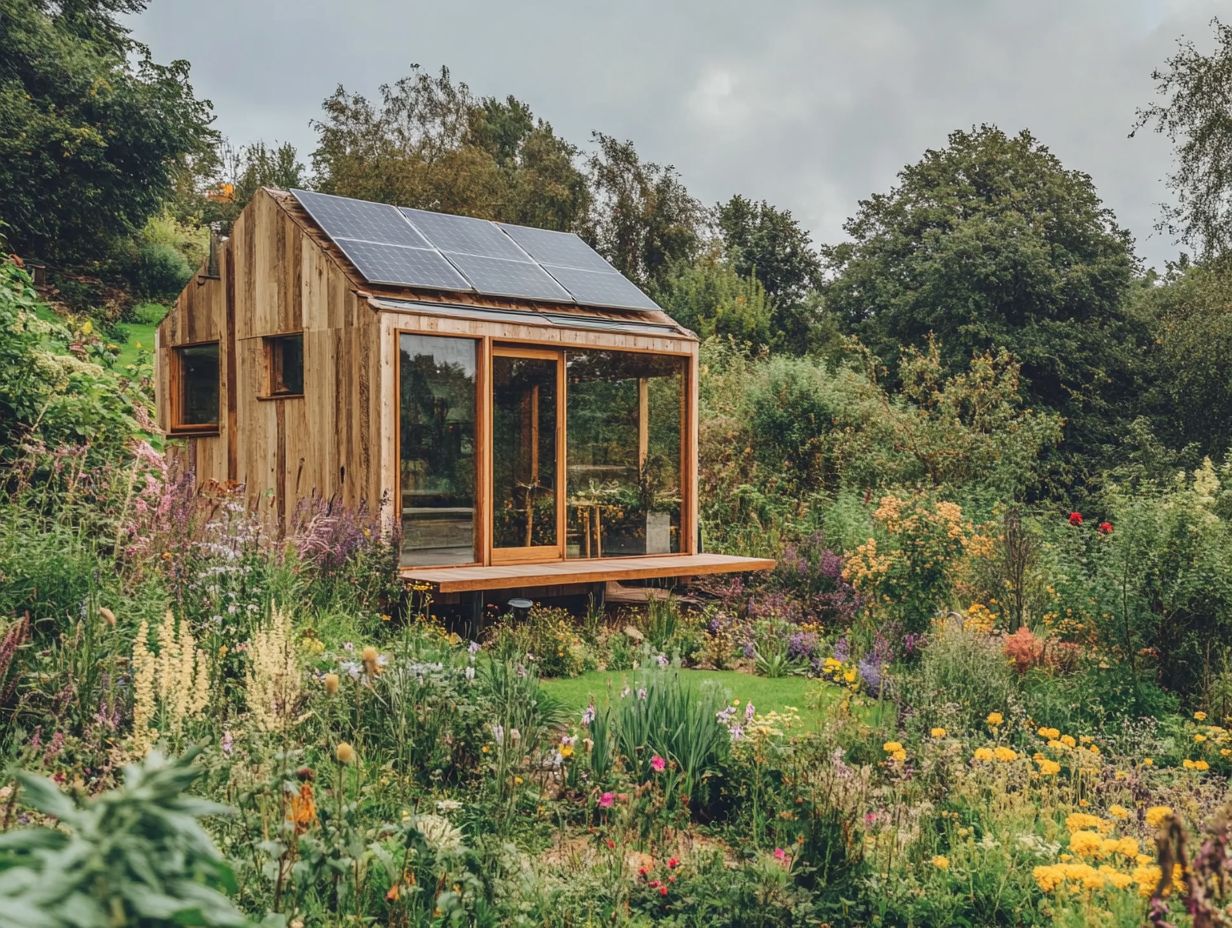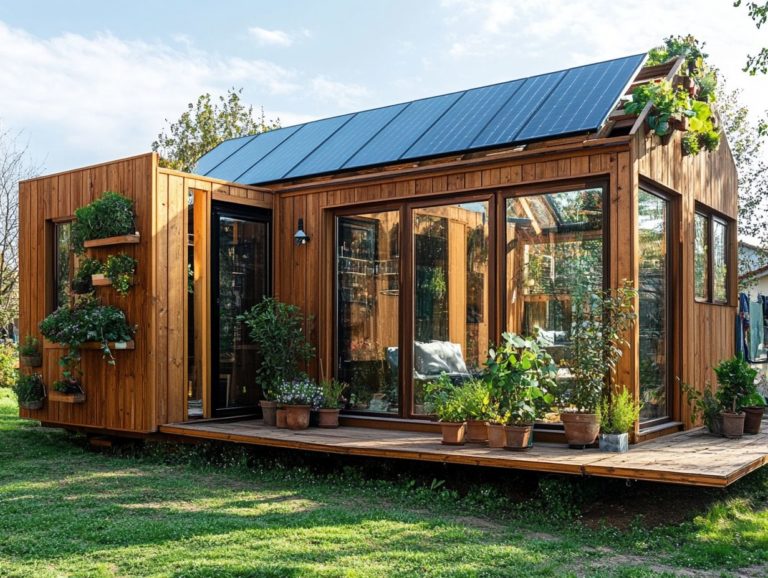The Environmental Impact of Sustainable Tiny House Materials
Sustainable tiny houses are not merely a passing fad; they embody a deliberate lifestyle choice that emphasizes environmental stewardship and the intelligent use of space.
This article delves into the principles of sustainable living and the advantages of incorporating eco-friendly materials into tiny house construction.
You will explore the diverse range of sustainable and recycled materials available to you, along with practical considerations such as durability and cost.
We will guide you through the essentials of designing and building your sustainable tiny home.
Uncover how your mindful decisions can lead to a smaller ecological footprint and a more enriching lifestyle.
Contents
- Key Takeaways:
- The Concept of Sustainable Tiny Houses
- Benefits of Using Sustainable Materials in Tiny Houses
- Types of Sustainable Materials for Tiny Houses
- Considerations When Choosing Materials
- Building and Designing a Sustainable Tiny House
- Frequently Asked Questions
- What is the environmental impact of using sustainable materials in tiny houses?
- How do sustainable materials benefit the environment in tiny houses?
- What are examples of sustainable materials used in tiny houses?
- Do sustainable materials in tiny houses cost more?
- How can using sustainable materials in tiny houses contribute to a greener future?
- Are sustainable materials in tiny houses easy to find?
Key Takeaways:

- Sustainable tiny houses promote eco-friendly living in compact spaces.
- Using sustainable materials reduces the environmental impact and saves on costs.
- Natural, recycled, and energy-efficient materials are ideal for building a sustainable tiny house.
The Concept of Sustainable Tiny Houses
The concept of sustainable tiny houses is rapidly becoming a compelling solution to the housing crisis, especially in urban environments. This movement champions affordable housing options that embrace sustainable living and energy efficiency, all while striving to minimize carbon footprints and foster a sense of community.
By employing smart design ideas and using eco-friendly materials, the tiny house movement promotes a minimalist lifestyle that resonates with the increasing demand for both environmental benefits and financial practicality. Exploring the future of sustainable materials in tiny housing can further enhance this movement.
Defining Sustainable Living and Tiny Houses
Sustainable living underscores the significance of minimizing your environmental impact, and tiny houses perfectly embody this principle by supporting a simpler way of living and the use of eco-friendly materials.
These compact dwellings are crafted with efficiency in mind, often employing innovative construction techniques that reduce waste while maximizing functionality. By integrating renewable resources such as solar panels or rainwater harvesting systems, tiny homes not only shrink their carbon footprint but also enable you to embrace a more self-sufficient lifestyle. Additionally, using earthbags for sustainable tiny house building can further enhance this eco-friendly approach.
This minimalist approach inspires you to prioritize experiences over possessions, cutting back on what you buy and cultivating a deeper appreciation for the essentials. Aligning with the principles of sustainable living not only enhances your personal well-being but also contributes positively to the health of our planet.
Benefits of Using Sustainable Materials in Tiny Houses
By incorporating sustainable materials in your tiny house, you not only elevate energy efficiency but also achieve substantial cost savings while minimizing emissions.
This approach makes tiny houses an appealing choice for homeowners who prioritize environmental consciousness.
Environmental Impact and Cost Savings
The environmental impact of choosing sustainable materials in tiny houses is truly remarkable. It often leads to significant cost savings through enhanced energy efficiency and reduced resource consumption.
For example, when you opt for reclaimed wood, you’re not just playing a part in minimizing deforestation; you could also save up to 20% on lumber costs. Incorporating energy-efficient appliances can slash your utility expenses by an average of 15-30%, and let s not forget solar panels, which can reduce your electricity bills to the point of eliminating them altogether.
A 2021 study revealed that tiny homes built with sustainable materials generate 40% fewer greenhouse gas emissions compared to traditional homes, highlighting the dual impact of these choices. By investing in eco-friendly resources, you are not only protecting the planet but also reaping long-term financial benefits, making sustainable living an exceptionally smart choice. For those considering building, exploring the top 10 sustainable building techniques for tiny houses can provide valuable insights.
Types of Sustainable Materials for Tiny Houses

When you embark on constructing tiny houses, consider an array of sustainable materials at your disposal. Opt for natural and recycled options that not only offer durability and energy efficiency but also significantly reduce your environmental footprint.
Start your journey toward sustainable living today!
Natural and Recycled Materials
Choosing the right materials can turn your tiny house dreams into reality! Natural and recycled materials play a crucial role in constructing tiny homes. They provide eco-friendly solutions that champion sustainability while elevating the aesthetic appeal.
Take reclaimed wood, for example. It s often used in structural components and interior finishes. This adds a rustic charm and cleverly reduces the need for new timber, helping to preserve our precious forests.
Bamboo is another great option. Celebrated for its rapid growth and impressive strength, it makes for a stunning flooring choice that complements minimalist designs beautifully and is highly renewable.
Imagine how cool it is that some tiny homes use recycled steel for framing! This ensures durability while minimizing waste from construction sites.
By opting for these materials, you not only contribute to a lower carbon footprint but also cultivate a deeper connection to the environment, making them perfect for anyone seeking a harmonious lifestyle.
Energy-Efficient Materials
Energy-efficient materials are essential for your tiny house! They significantly reduce overall energy consumption and support a sustainable lifestyle, making your home not only environmentally friendly but also economically viable.
These materials think insulated panels and low-E windows maximize temperature control while cutting down on your reliance on heating and cooling systems. For example, reclaimed wood adds unique charm while reducing the need for new materials, effectively lowering your carbon footprint.
Let’s not forget about high-efficiency appliances; they can boost your energy savings even further! By prioritizing innovative solutions, you can craft a tiny home that isn’t just cozy but also aligns perfectly with your environmental aspirations.
Considerations When Choosing Materials
When selecting materials for tiny houses, you must thoughtfully consider factors like durability, maintenance, availability, and cost. Each of these elements is essential for ensuring the longevity and effectiveness of sustainable living.
Your choices significantly influence not just the aesthetics but also the resilience and practicality of your space.
Durability and Maintenance
Durability and maintenance are paramount when selecting materials for your tiny house! These factors ensure the sustainability and longevity of your eco-friendly oasis.
Tiny homes, often nestled in compact spaces, thrive on materials that can withstand the elements while requiring minimal upkeep. For instance, consider fiber-cement siding. Its remarkable resistance to moisture and pests means you can wave goodbye to frequent repairs or replacements.
Similarly, opting for metal roofing guarantees an exceptional lifespan, often surpassing 50 years, with just the occasional cleaning to keep it looking sharp.
Using high-quality plywood or oriented strand board (OSB) in the structural framework enhances stability and resists warping. This effectively reduces your maintenance efforts over time. By choosing resilient materials, you’ll create a tiny dwelling that not only stands the test of time but also complements a low-maintenance lifestyle. Additionally, embracing the importance of sustainability in tiny house communities will further enhance your living experience.
Availability and Cost

The availability and cost of sustainable materials are crucial factors when designing tiny houses! These elements can greatly impact the project’s financial viability.
You must thoroughly investigate local supply chains, explore renewable resource options, and keep an eye on price fluctuations driven by demand. Quality and accessibility can vary significantly depending on your region, often determining whether your project stays within budget.
Sourcing eco-friendly materials might involve extra shipping costs or require specialized labor, adding complexity to the financial picture.
Understanding these variables is essential, as they ultimately influence your choice of construction methods and the sustainable features you can realistically implement. This knowledge shapes the feasibility of crafting a budget-friendly yet environmentally responsible tiny home, emphasizing the role of sustainability in tiny house construction.
In conclusion, choosing sustainable materials is vital for creating a tiny home that reflects your values and aspirations. Embrace eco-friendly options, such as using recycled materials in tiny house designs, and make a positive impact while enjoying your cozy, stylish space!
Building and Designing a Sustainable Tiny House
Building and designing a sustainable tiny house requires adhering to local building codes while embracing innovative design principles. By using eco-friendly materials and fostering a sense of community living, you create a space that meets regulations and enhances your lifestyle and the environment.
Incorporating Sustainable Materials into the Design
Using sustainable materials in your tiny home design is essential for achieving both functionality and aesthetic charm while embracing an eco-friendly lifestyle.
By thoughtfully selecting eco-conscious components, such as reclaimed wood for flooring and bamboo for furniture, you cultivate a warm atmosphere. This approach promotes sustainable living practices crucial for addressing the housing crisis and affordable housing, significantly reducing your ecological footprint. Additionally, understanding the impact of sustainable materials on tiny house value can further enhance your investment in a more eco-friendly lifestyle.
Integrating natural insulation materials that enhance energy efficiency, like sheep s wool or recycled denim, boosts your home s energy efficiency while fostering a healthier indoor environment.
These strategies showcase your commitment to a green lifestyle! Opting for multi-functional furniture crafted from sustainable sources allows you to enjoy both quality and practicality without the burden of excess clutter, perfectly embodying the tiny house philosophy. Additionally, understanding biodegradable materials for tiny houses can further enhance your eco-friendly living experience.
Tips for Reducing Waste during Construction
Reducing waste during tiny house construction is crucial for promoting sustainability. You can achieve this through various practical tips and practices.
Start with meticulous planning. Strategically designing the layout and dimensions can significantly minimize excess materials. Choosing sustainable materials, like reclaimed wood or bamboo, not only cuts down on waste but infuses your structure with unique character.
Implementing a thorough recycling protocol on-site ensures that scrap materials and packaging are efficiently sorted for reuse. Partner with local suppliers who prioritize eco-friendly products to enhance the sustainability of your project and stay informed about the future of sustainable materials in tiny housing.
Educating your construction crew about effective waste management practices fosters a shared sense of responsibility, encouraging a collective effort to minimize the environmental impact of sustainable materials, especially in remote working scenarios.
Frequently Asked Questions
What is the environmental impact of using sustainable materials in tiny houses?

The use of sustainable materials in tiny houses has a positive environmental impact. It significantly reduces carbon emissions, minimizes waste, and promotes resource conservation.
How do sustainable materials benefit the environment in tiny houses?
Sustainable materials promote energy efficiency, reduce the need for natural resource extraction, and support eco-friendly building practices.
What are examples of sustainable materials used in tiny houses?
Examples of sustainable materials used in tiny houses include reclaimed wood, recycled plastic, bamboo, and natural fiber insulation.
Do sustainable materials in tiny houses cost more?
While sustainable materials may have a higher initial cost, they often lead to long-term savings through energy efficiency, durability, and reduced maintenance costs.
How can using sustainable materials in tiny houses contribute to a greener future?
By supporting sustainable building practices, the use of sustainable materials in tiny houses helps reduce the overall environmental impact of the construction industry and promotes a more sustainable future.
Are sustainable materials in tiny houses easy to find?
Eco-friendly building materials are in high demand. You can find many sustainable options for tiny houses, both online and at local suppliers.
Discover the amazing variety of options available to create your dream tiny house today!






